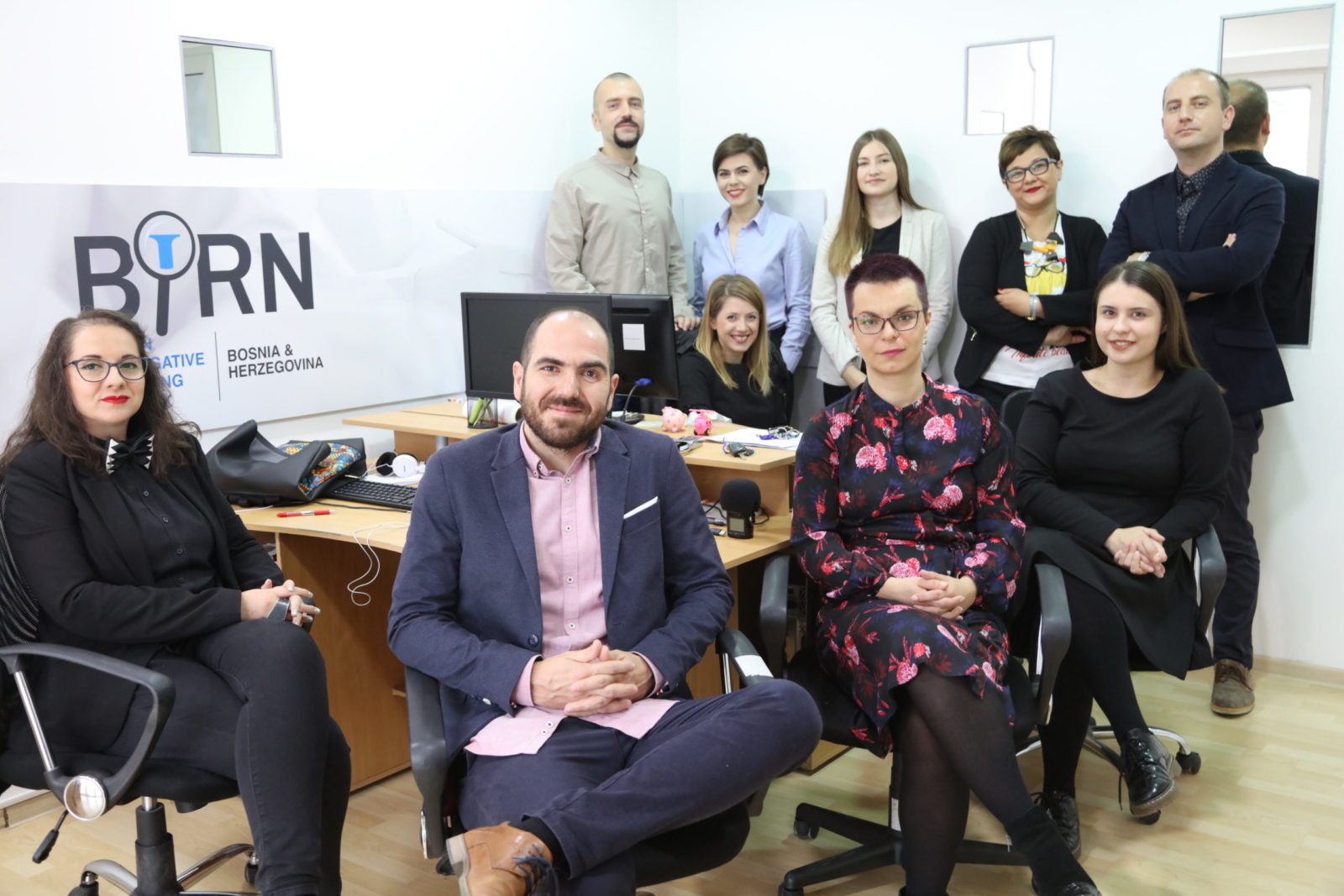Balkan Investigative Reporting Network Bosnia and Herzegovina
About BIRN BiH
BIRN BiH is a non-governmental organisation based in Sarajevo that specialises in monitoring and reporting on war crime trials and transitional justice processes, giving a voice to the victims. The organisation was founded in 2005 with the aim of providing people in Bosnia and Herzegovina with objective and timely information about the rule of law in the country and the wider region.
BIRN BiH is the first organisation, and to this day the only one, to provide continual coverage of war crime trials to the public in Bosnia and Herzegovina, thus creating a unique archive of more than 29,000 articles in the Bosnian and English language. BIRN BiH’s journalists have covered over 590 war crime cases in the country’s twenty domestic courts and at international courts as well.
Being present at war crime hearings allows BIRN BiH’s journalists to write unbiased reports, but also allows them to act as watchdogs, detecting and reporting on ongoing problems with the judiciary and advocating for their resolution. This is relevant for dealing with the past but also for investing in the future, helping society and public institutions in Bosnia and Herzegovina with democratisation and rule of law processes.
Along with trial monitoring, BIRN BiH specialises in investigative jour- nalism and in-depth coverage of topics such as the rise of extremism and radicalisation, both religious and far-right, as well as malign foreign influence, corruption and processes of facing the past, plus lectures and training sessions for both domestic and international journalists and researchers.
Over the years, BIRN BiH’s reports on unprosecuted crimes have had a significant impact and victims who have trusted us to tell their stories for the first time have seen their cases picked up by prosecutors. In November 2019, the Bosnian state court sentenced a former Bosnian Serb fighter to twelve years in prison for raping a woman in Bratunac in 1992, after the victim in the case spoke publicly for the very first time about what she lived through on BIRN BiH’s monthly “TV Justice” programme, which is aired by the state broadcaster and seventeen local TV stations.
BIRN BiH is part of a regional network of non-governmental organisations promoting freedom of speech, human rights and democratic values in Southern and Eastern Europe gathered around an umbrella organisation – the Balkan Investigative Regional Reporting Network (BIRN Hub) – a structure that has the advantage of combining local, country-based expertise with unique regional cooperation.
Documentaries and TV Justice
BIRN BiH has produced two documentary films – dealing with the issues of sexual violence in war and missing persons – as well as over 100 episodes of its “TV Justice” 30-minute monthly programme, which is aired by two of the country’s public broadcasters and over a dozen local TV stations.

Trial monitoring
BIRN BiH’s journalists have covered over 590 war crime cases at the Bosnian state court, the International Criminal Tribunal for the Former Yugoslavia, and local level courts in Bosnia and Herzegovina, creating a unique database of almost 30,000 articles.
Investigations, features and analysis
BIRN BiH’s journalists have been awarded for their investigative and analytical pieces about corruption and malign foreign influence. They have also developed a database on the public procurement of vehicles which was shortlisted for an international Sigma Data Journalism award.
Forgotten Victims – Investigative series on unprosecuted war crimes
Over the past fifteen years, BIRN BiH’s journalists have often been the sole media outlet giving victims and survivors of war a voice. We have conducted a campaign called “Stop Censorship of War Crimes,” calling for final verdicts for war crimes to be made publicly available. Currently, BIRN BiH has a project called “Forgotten Victims,” publishing investigative stories about crimes that remain unprosecuted twenty-five years after the war.
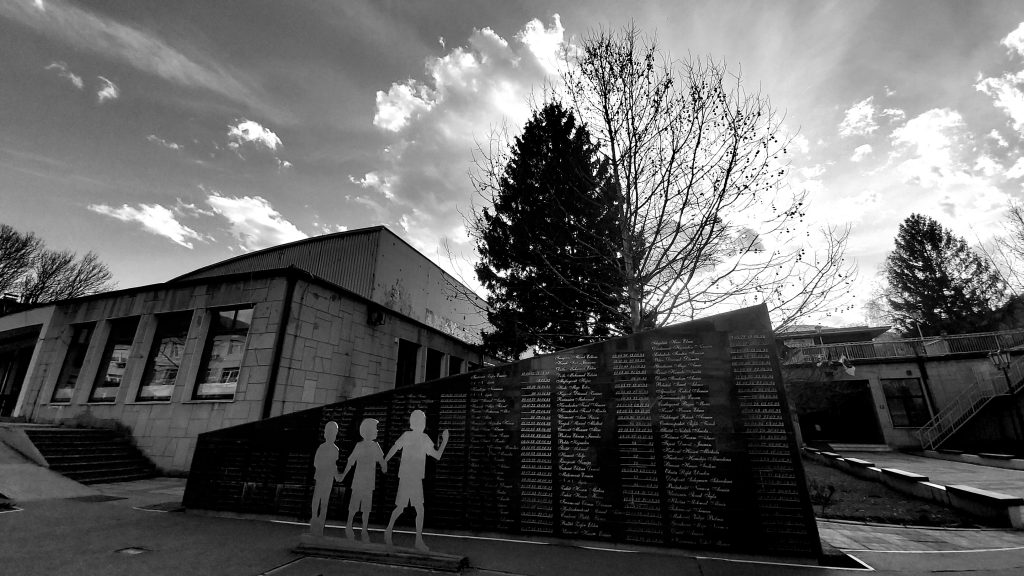
Sarajevo-Jerusalem
SARAJEVO-JERUSALEM 1 | 6
The Ordinary Heroes of the “Jerusalem of Europe”
Through the history of Sarajevo’s Jews, a journey in two cities on a quest for universality, symbols for the people of the Book, and epicentres of modern conflict. A journey towards a certain idea, real or imaginary, of coexistence. Today we look at the courage of a handful of men and women during the wars of the 20th century.
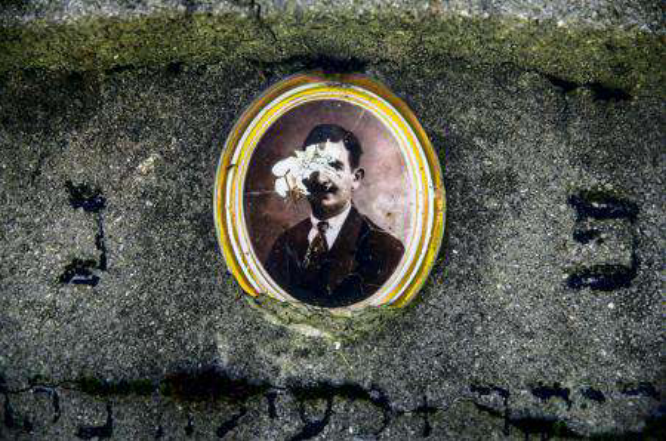
A stele in the Jewish cemetery in Sarajevo in May.
Photo: Damir Sagolj for Le Monde
It’s a day like any other during the Siege of Sarajevo. A Saturday in February with no snow or rain. A morning a little on the cold side, like any other morning in winter, and a little sad, like any other morning of the siege. Accompanied by her daughter Aida, her son-in-law and her granddaughter, Zeineba Hardaga has just got onto a bus that will take her away from her birth town forever. Servet Korkut has also got on this coach. No one knows if these two women know each other. Yet an invisible thread connects their lives.
It’s an ordinary Saturday in 1994, among the 1395 days of a besieged city at the edges of a Europe that is, at the end of the 20th century, overwhelmed with war, carnage and drama. That day could have been forgotten, like so many before and after. In Sarajevo, it was not.
Around midday, a Serbian army gun position launches a round of mortar shells from one of the surrounding hills. After grazing a roof, the 120mm mortar shell comes crashing down on the Markale market, on Marsala-Tita street. The explosion rips apart the bodies of the sellers and the onlookers. Not that there was much on sale that day in the surrounded and starving city but, when the morning is calm and even if they know the bombing always returns, Sarajevans walk around, share a cigarette and discuss the news from families and frontlines.
That mortar shell enters into History as being the deadliest of the war: 68 dead, 144 wounded. While the lengthy investigation of the International Criminal Tribunal concludes that it was a deliberate strike by the Serbian army on Markale market, and some of its generals would later be sentenced for the war crime, the gunner himself probably has no idea that on this day he will set a gruesome record in artillery history: 212 people scythed by one single mortar shell.
The horror of the carnage and the international reverberations divert attention away from what was happening right at the same moment, that February 5th, 1994, just five hundred metres away on Dobrovoljacka Street. Buses are setting off, transporting Zeineba Hardaga, Servet Korkut and three hundred other Sarajevans away from the city. While the journalists are busy rushing from the market to the hospital, from the hospital to the morgue and from the morgue to their satellite phones, this story goes unnoticed.
That day could have been forgotten, like so many before and after. In Sarajevo, it was not.
A lot of the passengers on this bus know each other: they are the last Sarajevan Jews fleeing hell, thanks to this eighth and final evacuation convoy of the war. Zeineba Hardaga has a particular status amongst the group. Not only can she not name any Jewish ancestors amongst her relatives but she is a Muslim and the only passenger to be an honorary guest of Israel, the final destination of these refugees. She is due to be met by Prime Minister Yitzhak Rabin. The other elderly woman, Servet Korkut, is also a Muslim with a particular attribute but, as opposed to Zeineba Hardaga, she doesn’t know it yet. Her destination is Paris, where her son Munib has taken refuge at the end of the first year of the war.
If, on this morning, these two women find themselves with hundreds of others fleeing the “Little Jerusalem” or “Balkan Jerusalem”, as some of them like to call Sarajevo, it is because this is not their first war.
The other conflict they have lived through also started in April, when the German army and its Croatian Ustachi allies entered Sarajevo in 1941, fifty-one years before the collapse of Yugoslavia. The city is used to invaders, and is used to not worrying too much about them. Its Ottoman then Austro-Hungarian past has shaped a very particular identity, between East and West. The Sarajevan natural inclination towards indolence means that they have always viewed each new pretender to power with wariness, without hate or prejudice towards them. The other trait of this provincial city with a majority of Muslims, tucked away in the mountains and neither possessing the strategic or economic attractions of Constantinople or Salonika, is that it is a very Jewish city.
The good neighbour as way of life
The story of the Sarajevan Jews is that of the Spanish Sephardim – before some Ashkenazi Jews joined them coming from the north during the Austro-Hungarian Empire. A little after the end of the Reconquista and the Catholic armies’ entry into Toledo in 1942, the Spanish sovereigns, Ferdinand and Isabelle, offered Jews the choice of either conversion or exile, brutally drawing to a close what Sephardi history holds as its Iberian golden age. As a community fleeing Christian Europe, they went on to take refuge in the heart of Muslim lands, from North Africa to the Balkans and to the Middle East.
The first fifteen Jewish families of Sarajevo are merchants from Salonika who arrive in 1565. They speak Ladino (also called Judeo-Spanish), a language close to Castilian which they will retain as a community and family language until the 20th century. The Ottomans allocate them a neighbourhood in the old town and permit them to build their first synagogue (the town would have up to six sites of Jewish worship in 1941). The neighbourhood, which translates as “The Courtyard” (Cifut Han in Turkish, Il Kurtijo in Ladino) is not a ghetto and is populated only by the poor. Other Jews come and live in the Bjelave neighbourhood, then elsewhere in Sarajevo.
Over the centuries, even though some of the administrative rules are discriminatory, no political power, be it Ottoman, Austro-Hungarian or Yugoslavian, persecutes the Sarajevan Jews.
In April 1941, the German army and its Croatian Ustachi allies, enter Sarajevo. The tracking of the Jews begins
By all accounts, this is a town that welcomes them. And far from the modern terminology making Sarajevo a “multi-ethnic” symbol during the war of the end of the 20th century, its inhabitants have always cultivated what they call komsiluk, which is to be a good neighbour. Nothing here (the nation, the community, or religion) in times of peace and even during periods of political tension or war, can take precedence over the relationship with komsije, with the neighbours. Generally accepting about whoever is in charge in Constantinople or Vienna, it reflects how Sarajevans live side by side with respect for each other’s communities, religions and traditions.
In that month of April 1941, Zeineba Hardaga is with her husband, Mustafa Hardaga, and she barely gives a thought to what is going on in the capitals of their new masters, Berlin and Zagreb. In any case, how could they imagine the unimaginable? Especially since this town like a lost island is where, above and beyond its Muslim, Christian and Jewish traditions, the real religion could only ever be the gentleness of co-existence, the only city in Europe able to claim to have never had a Jewish ghetto. Who could imagine Auschwitz here? The Hardagas have only ever worried about their family, and their neighbours.
In their case, their neighbours are called the Kabilios, and they are Jewish. Mustafa Hardaga and Josef Kabilio like to sit and talk together, they have become genuine friends. In When Neighbours Were Real Human Beings (University of Sarajevo, 2010), the historian Eli Tauber gives an account of the good neighbour relationship that is typically Sarajevan: “Each family maintains a high level of respect for the customs of the other. The Hardaga family women would not clean or dust their rugs on the shabbat, in order not to disturb the atmosphere of rest and celebration that reigned in the synagogue next door. The Kabilios were careful not to have too many festive activities during Ramadan, mindful not to make fasting any more difficult for the Hardaga family.”
When the persecutors begin hunting down Jewish people, the Hardagas take the Kabilios into their home. Josef Kabilio quickly gets his family to safety in Mostar, in the Italian occupation zone. There, in Herzegovina and Dalmatia, Jews are discriminated against and put in detention camps but they are not exterminated and the majority will survive the war. But Josef Kabilio becomes overconfident and returns on his own to Sarajevo. He is arrested by the occupiers, manages to escape and yet again takes refuge with the Hardagas, who hide him for months before he can get back to his family.
Atheists, communists and not very Jewish
After the war, Zeineba Hardaga spoke about how they and the Kabilios formed “one single family” during those troubled times, how the women took off their veils for the first time in front of a stranger, and received into their home a neighbour who had become a brother. When the Kabilios return to Sarajevo in 1945, they stay with the Hardagas again. They find their hidden-away box of rings carefully watched over for them, ensuring they can emigrate to Israel and start a new life. Josef Kabilio will give his testimony to Yad Vashem, the Jerusalem memorial paying tribute to Gentiles who saved Jews during the Holocaust, and Mustafa and Zeineba Hardaga will be awarded, in 1984, the honour of “Righteous Among the Nations”.
The story of the Hardagas and the Kabilios is far from being a unique one in Sarajevo. On that bus of 5th February 1994, Servet Korkut’s life is also an echo of Zeineba Hardaga’s, again casting a light on the Second World War.
They find their hidden-away box of rings carefully watched over for them, ensuring they can emigrate to Israel and start a new life
One morning in the winter of 1942, after having spent a night sleeping on a bench in Sarajevo, a young Jewish woman called Mira Papo meets a neighbour from before the war. As opposed to the huge majority of Sarajevan Jews, hers is a unique story. She has managed to evade the roundups and deportations through escaping to the mountains and joining the Partisans, Tito’s communist guerrillas. One day, her commander made the decision to expulse the thirty-two Jewish fighters in the unit, ordering them to return to occupied Sarajevo. “Apparently it was a one-off event in the Partisans and when told about it, Tito himself gave the order that it should never happen again”, the son of Mira Papo, Davor Bakovic, explains. Today, he lives in the Moshav (community village) of Neve Ilan, in Israel. “Of those thirty-two Jews, only my mother survived.”
The neighbour insists that Mira Papo waits in the park for him. He comes back accompanied by a very elegant man wearing a fez. The man introduces himself: he is called Dervis Korkut and is the librarian of the museum. He lives with his wife Servet and their newborn, Munib. He offers to conceal Mira Papo and takes her back to his home. To neighbours and visitors, they make out that she is a cousin from the countryside, who has come to help Servet look after the house and baby. The young woman cannot say a word in front of anyone, because the Korkut family only speaks Albanian, Servet’s native language, at home. People would be confused if the cousin from the countryside were to speak Serbo-Croatian. “My mother gave Mira Papo a Muslim veil and together they would walk around Mejtas”, a neighbourhood in the centre of Sarajevo, Munib Korkut explains in his house perched upon a rock overlooking the Adriatic sea, in a village north of Dubrovnik called Zaton, in Croatia.
The young woman hides with the Korkuts for six months. After this, another neighbour, also party to the adventure, supplies her with false documents to leave the city and re-join the resistance movement, where she will stay until the end of the war.
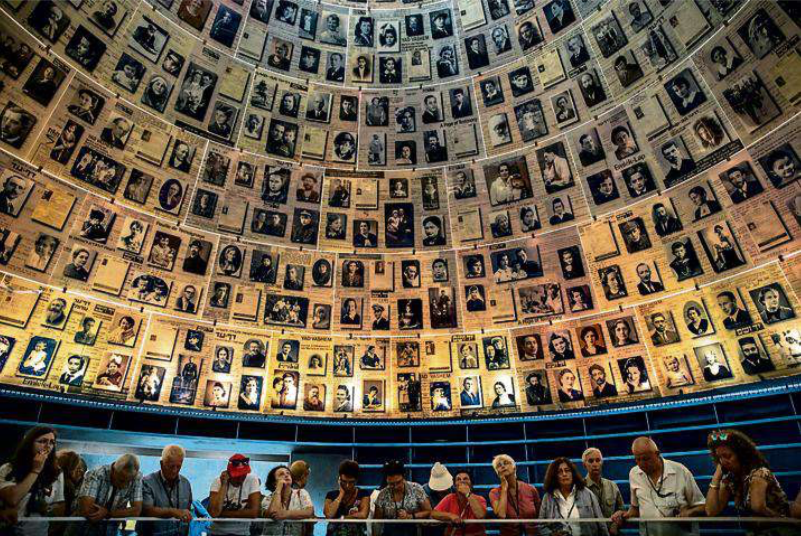
Museum of the History of the Shoah, Jerusalem, May 28.
Photo: Damir Sagolj for Le Monde
Escaping the deathly grasp of a Holocaust that killed 10,000 in Sarajevo, both the Kabilios and Mira Papo eventually headed for Jerusalem, in different eras and for different reasons. Not all Sarajevan Jews responded in exactly the same way to the founding of Israel. For some, it was an immediate call to leave a genocidal Europe, for others, the temptations of a new life, a promised-filled adventure. In Mira’s case and others like her, who were atheist, communist and not very Jewish, it proved to be a long journey towards their rediscovery of Judaism.
Mira had two boys, Daniel and Davor, with her officer husband Bozidar Bakovic only to become widowed soon after the war. Afterwards, Mira devotes herself to Tito’s Yugoslavian project, continuing her career in the army. An officer, she is transferred to Split, then Zadar, before settling for two decades in Rijeka, where she raises her children. It is there, on the Dalmatian coast, that she discovers her Jewish identity. It is not that this hardened socialist suddenly finds God or that she begins to attend religious services fervently. It is more about the pleasure she takes in educating her sons through contact with the community’s cultural activities, so much so, after their military service and university studies, when they are at an age to make the decision, they emigrate to Israel. Davor remembers his mother’s discovery of Jerusalem. “It was a dream for her. She lived there for the last twenty years of her life. The city reminded her of Sarajevo, and mostly, she spent her time with Yugoslavian friends.”
What her son has no idea about for a long time, is that Mira harbours a secret pain, “the great regret of her life”, he says. In 1945, in Sarajevo, a woman had stopped her in the street. It was Servet Korkut who revealed to her that her husband, Dervis Korkut, who had been such an honourable man and had saved Mira, had been arrested by the Yugoslavian police and was about be tried for collaborating with the Nazis. “The truth is my father was an anti-communist and did not hide it”, Munib Korkut says. Mira promised to come to the trial to testify in his favour but her son, Davor Bakovic, explains: “My father, an officer, convinced that she would be executed if she dared to contradict the official version, forbade her from going to the courthouse and locked her at home for several days. My mother was sure that Korkut was an extraordinary man and that he would be unfairly executed. She lived with the guilt of never having testified.”
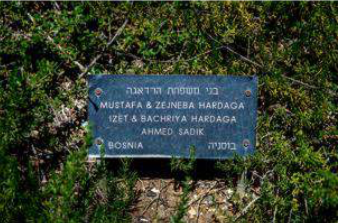
Yad Vashem memorial in Jerusalem: the plaque dedicated to the Hardaga family, who hid their Jewish neighbors during the Second World War
Photo: Damir Sagolj for Le Monde
“Righteous among the nations”
It is only at the end of her life, when war once again ravages Sarajevo, that Mira Bakovic learns by chance, from a newspaper article about the Sarajevo museum, that Dervis Korkut had not been condemned to death. In fact, he was freed from prison six years later and passed away peacefully in 1969. Still eaten away by guilt, and in the meantime having learnt of the existence of Yad Vashem memorial, she writes her testimony.
In its archives, Yad Vashem preserves all documents relating to the Righteous and the people they have saved. Recorded on a typewriter and signed by hand, Mira Bakovic-Papo’s letter, dated 20th February 1994, recounts the adventure of how her life was saved thanks to the Korkuts. Ten months later, on December 14, 1994, after an investigation, Yad Vashem bestowed the title of “Righteous among the Nations” to Dervis Korkut posthumously and to Servet Korkut, who will be handed her medal by the Israeli ambassador to France. Her son lived in Paris at the time and she was joining him as she steps on that bus in Sarajevo. Munib Korkut then receives a phone call from Jerusalem, from Mira, who shares with him how she “carried this weight all her life” and how happy she is that his father is honoured in this way, even if many years after his death.
And by these bonds forged through five centuries of communities living together, through some people’s heroism during the Second World War, the rescue operation of Jews during Sarajevo’s siege and the buses carrying the Righteous Zeineba Hardaga and Servet Korkut along with many other towards new horizons, something else was forged. Above and beyond the waves of immigration between the cities, it created a special tie between Sarajevo and Israel.
“My son, we didn’t save Jews, we saved our neighbours”
– Zeineba Hardaga, Muslim from Sarajevo
These individual destinies, and so many others, make you go on a journey through the history of Sarajevo’s Jewish community and then on to a certain idea, real or imaginary, of coexistence. To explore these two cities is to understand their symbolism for the people of the Book but also for the fractured world of today: Sarajevo, the last “Jerusalem of Europe”, the first place to have been a target of the return of nationalist ideology in Europe thirty years ago, a city besieged at the end of the 20th century; Jerusalem, the centre of the world, holy city of three monotheistic peoples, the epicentre of the tumult in the Middle East and of the Israeli-Palestine conflict. Two Jerusalems both on a quest for, but also refusing, a hypothetical notion of “cosmopolitanism”. Two cities often mired in hatred, war, nationalist division and religious intolerance. Depending on the era, two cities that embody the destruction or gentleness of life. Two cities at the ends of the world, islands but also bridges. Two cities that attract the world’s attention and tell a universal story.
Zeineba Hardaga died in the Holy Land, which, in principle, had never been promised to her. “When she arrived in Israel, we, as Jews of the former Yugoslavia, went to the airport to greet her, recalls Eliezer Papo, the rabbi of Sarajevo, who lives in Jerusalem and at the time was a student in Judaism. A minister made a fine speech on how Israel would never forget those who had rescued the Jews during the worst time in history for the Jewish people. Zeineiba had these words for the minister: “My son, we did not save Jews, we saved our neighbours.” We were all deeply moved. It was magnificent, so humble, and it was the truth.”
Her daughter Aida, born from Zeinaba’s second marriage, converted to Judaism and became Sara, a name chosen as a homage to Sarajevo. She works in the archive department of Yad Vashem, the institution which praised her mother and allowed her family to escape the hell of Sarajevo and come to Jerusalem in search of a better life.
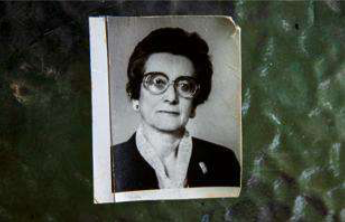
Portrait of Mira Papo, a Jew from Sarajevo who was saved by the Korkuts, a Muslim Sarajevo family.
Photo: Damir Sagolj for Le Monde
Full circle
As for the Korkuts, it did not take long before their descendants also took the road to Jerusalem. Having married the Kosovan Vllaznim Jaha, their eldest daughter, Lamija, lived in Pristina, unaffected by the siege of Sarajevo. But then the war reached her in 1999, when Belgrade, fighting against Kosovan guerrillas, deported non-Serbian Kosovans on a massive scale.
Having sent her children in advance to safety with a friend in Budapest, she flees to Skopje, Macedonia, with her husband. On her arrival, she shows leaders of the Jewish community the Yad Vashem certificate honouring her parents. The Jewish centres of Skopje and Budapest work together to organise the couple’s passage to Israel, their children following a few days later. As they arrive at Ben-Gurion Airport, amongst the crowd of officials and journalists, an unidentified man steps forward and addresses Lamija Jaha in Serbo-Croatian. “Hello, my name is Davor Bakovic, and I am the son of Mira Papo.”
One war later, destiny has come full circle. Fifty years after Dervis Korkut met Mira Papo on a bench in Sarajevo and took her into his home, Davor, a Sarajevan become Israeli, receives Lamija, a Sarajevan become Kosovan, in the land of Israel. The Bakovics help the Jahas to settle in. “For the only time in my life, I felt a closeness and an immediate friendship”, says Davor, in an emotion-filled voice.
And yet it is not for Mira Papo’s rescue that the museum librarian Dervis Korkut, dead long before his name was inscribed on the Wall of Remembrance in Yad Vashem’s Garden of the Righteous, remains in the memory of the city. It is an act far more mysterious and today much more famous that propelled him into the legend of Sarajevo.
SARAJEVO-JERUSALEM 2 | 6
Saving the Sarajevo Haggadah
Coveted by the Nazis in 1942 then threatened by Serbian bombs in the Bosnian War, this fabled 14th century manuscript recounting the Hebrews’ exodus from Egypt had to be hidden several times. Today, it takes pride of place in the town’s national museum.
When the German General Johann Fortner introduces himself to Jozo Petrovic, the director of the Sarajevo Museum in 1942, he knows exactly what he is looking for. His orders are clear: in the name of Nazi Germany, the general must lay his hands on the Sarajevo Haggadah, the museum’s masterpiece and one of the most precious Hebrew manuscripts in the world.
In Berlin, three competing institutions share the task of plundering Jewish treasure across Europe: The Reichsleiter Rosenberg Taskforce, led by Hitler’s close associate and chief ideologue of national-socialism, Alfred Rosenberg; the Ahnenerbe presided over by the Reichsführer Heinrich Himmler; and last, the Sonderkommando Künsberg. Under the guise of archaeological, cultural and anthropological studies, their objective is to prove the Aryan race’s superiority. Suffice to say, although he is already handling the deportation of six thousand Sarajevan Jews and the communist resistance rearing its head in the surrounding mountains, General Fortner, Commander of the 718th Infantry Division based in the region and mandated by the Einsatzstab Rosenberg, is undoubtedly not taking it lightly.
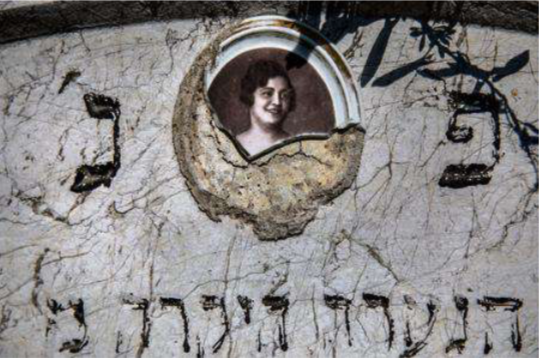
A stele in the Jewish cemetery in Sarajevo in May.
Photo: Damir Sagolj for Le Monde
The Sarajevo Haggadah is an illuminated manuscript containing the text of the Haggadah, the story of the Hebrew exodus from Egypt, read for two thousand years on Passover, the Jewish Easter. Its richness and perfectly preserved illustrations make it the most precious Sephardic Haggadah in the world.
Its story is one of a thousand mysteries and it inspires as many legends. Even its place and date of creation are unknown. According to experts, it was most likely created in Aragon, in the north of Spain, in the 14th century. The details of how it survived the Expulsion of 1492, which saw the Catholic kings drive the Jews out of Spain and destroy their heritage, are equally unknown. No doubt a family took it with them as they headed for exile towards the east. Historians have put forward possible theories about its passage to Dubrovnik or Salonika, without ever being able to furnish evidence. The only viable information that has emerged since its re-apparition in Sarajevo is that it passed through the hands of a catholic priest, Giovanni Domenico Vistorini, in the Venice region, in 1609. He appended his signature to the manuscript, saving it from the Church’s censorship.
It is a man named Josef Cohen who brings the Haggadah to the Sarajevo Museum, in 1894. Poor and needing to feed his family, it is with a heavy heart that he decided to give up the book after the death of his father. He sold it to the museum for 150 Austro-Hungarian crowns. The manuscript is then sent to Vienna to be evaluated. Viennese curators concluded it was masterpiece, one of a kind, which did not stop them from giving it a brand new and tacky cover. At least the evaluation ensured the book acquired the name it bears to this day, Die Haggadah von Sarajevo. The Hebrew manuscript was returned to its place in the Sarajevan museum collection, where it would seldom be exhibited for a century.
When, in 1942, General Johann Fortner presented himself to Jozo Petrovic, the museum director, unable to speak German, asked the librarian Dervis Korkut to join them in his office. The German officer’s visit having never been officially reported, the only account of it is that given by Dervis Korkut and his wife Servet, after the Second World War.
Its story is one of a thousand mysteries and it inspires as many legends.
Dervis “Efendi” Korkut is a man of a certain status in Sarajevo. His integrity and erudition have earned him the trust of both the museum’s director, Petrovic, and its curators. Before becoming guardian of the books in the museum, he had studied Islamic theology in Istanbul and Oriental languages in Paris. He speaks twelve languages. He loves history and traditions. “He was a living encyclopaedia and he was very respected in Sarajevo”, his son, Munib Korkut, says. Before the war, this pious man, decent and respectful of others, had written a text warning of the rise of antisemitism and praising his city’s inter-community relations.
So, when General Fortner asks to see the Haggadah, for Korkut, no worse fate could have befallen him. The museum’s director and the librarian know perfectly well of the priceless value of the manuscript. Dervis Korkut, a courageous man with profound anti-fascist convictions, loathes those who lack culture, who profane the sacred and who hunt down Jewish treasures. He cannot hand over the Haggadah to the Nazis.
Nestled amongst the Korans
In Zaton, a village by the Adriatic sea, where he retired after having been a refugee in Paris, Munib Korkut opens — after having served a welcome loza (grape brandy) — a bottle of dalmatian white wine and recollects. “My father told me the story of the Haggadah when I was an teenager, after the war. He said to me: “One day, a German officer arrived at the museum, and as Jozo Petrovic could not speak German he called me. The officer asked to see the museum. During the visit, he requested to see the Haggadah. So, I answered: “I’m sorry but another German officer came two hours ago and took away the Haggadah.” Furious, the officer left.”
What became of the Haggadah after General Fortner, who must have searched for ever for the identity of the other officer who had taken the treasure, left? “My father brought the Haggadah to our house, explains Munib Korkut, still wandering through his adolescent memories. A few days later, he entrusted it to a hodja (imam) who hid it in a village mosque near the Treskavica mountains. After the war, the hodja came to return the book and my father brought it back to the museum.”
In Sarajevo, countless stories circulate the city about the fate of the Haggadah during the Second World War. The mosque referred to by Dervis Korkut was said to be in Treskavica, or Bjelasnica or Igman, all three neighbouring mountains west of Sarajevo, however no one has ever found the village, the mosque or the imam.
“My husband had returned home with the Haggadah hidden under his jacket. He said to me: “No one should know, or they will kill us and destroy the book”.”
– Servet Korkut
Popular legends gladly add intriguing details: the Hebrew book could have been hidden in the mosque’s library, amongst the Korans, a Holy book among other Holy books, or have been buried in the mosque’s garden under a tree. When met and asked about it in Jerusalem, Eliezer Papo, the Rabbi of Sarajevo says, “Dervis Korkuk was an intellectual, an erudite man and would have never buried the Haggadah under a tree”.
Dervis Korkut was not a man to boast about his achievements. In fact, after the war, he never spoke to anyone about his act of hiding the young Jewish woman Mira Papo which would see him honoured as “Righteous Among the Nations” posthumously in Jerusalem. Nothing indicates that he ever spoke about his rescue of the Sarajevo Haggadah either, other than to his wife and on one occasion to his son Munib.
The other known details come from Servet Korkut, who spoke about the story after her husband’s death in 1969, first to her children, then in the last ten years of her life to a range of visitors, journalists and historians as the Sarajevo Haggadah became famous worldwide due to the Bosnian war (1992-1995).
In particular, she met the Australian journalist and novelist Geraldine Brooks who, before writing a novel inspired by the story of the Haggadah (People of the Book, Viking Penguin, 2008) published the interview in the New Yorker (“The Book of Exodus”, 3rd December 2007). The version recorded by Brooks matches with that given by the son: “My husband came back home for lunch with the Haggadah hidden under his jacket. He told me: “Say nothing to anyone. No one must know or they will kill us and destroy the book.” That afternoon, he went to Visoko, where one of his sisters lived, under the pretext of visiting her. From there, he took the book to a village tucked away in the Treskavica mountains, where his friend was the hodza of a little mosque. The Haggadah was hidden among the Korans and other Islamic books for the duration of the war”.
The youngest daughter of Servet, Lamija Jaha, lived, between two exiles in Israel and then in Canada, in Sarajevo with her mother during the last four years of her life. She often heard her mother telling the story to visitors. However, she recounts a detail that contradicts previous versions on one point, which would throw light on why the location of the Haggadah’s hiding place has never been found: “I always heard my mother say my father brought back the Haggadah to the house, hidden in his clothes. She then said that he had entrusted it to a friend who lived near the village of Travnik.” The fact that Dervis Korkuk was born in Travnik, a small town in central Bosnia and previously the Pachaluk (headquarters) of Bosnia when it was part of the Ottoman empire, gives credence to the hypothesis that he entrusted the treasure to a childhood friend who had become an imam is not an implausible one.
Sarajevo on the brink of collapse
The really funny side to the story is that while Sarajevo is a city brimming with one legend more spectacular than the next about the Haggadah, a great number of museum professionals do not believe a word of the Korkut family’s story. It is as if they cannot bring themselves to admit that their predecessors, such humble and serious professionals, could have let this jewel slip through their hands during a few troubled years. Mirsad Sijaric, the current director of the museum, who fought to defend the city during the siege before returning to his history studies, bats away all such stories. He wants it to be known: “I am sure the Haggadah never left this museum. We have a library of over 350,000 books and had maybe 100,000 books during that era. What better place than here to hide a book? We do not have any official documents proving the Haggadah was hidden elsewhere.”
This opinion, founded on the absence of archived documents, does not explain why Servet Korkut remembers her husband bringing home a book so precious that it could endanger their lives, or why Dervis Korkut, a man of integrity, would have lied to his adolescent son. Either way, the Sarajevo Haggadah is part of the museum collection in 1945. After having survived the destruction of Jewish treasures in Spain in the 15th century and eluding the Nazis in the 20th century, this was not, however, the end of its tumultuous destiny…
In the spring of 1992, war comes back to Sarajevo. This time, no enemy officer is on a quest for Jewish treasures, but the Serbian army bombs the city relentlessly. Sarajevo shakes, burns and threatens to collapse. The Haggadah is once again in danger as the national museum finds itself on the frontline. While, all around the city, those laying siege have positioned their canons on the surrounding hills, this is the place where the frontline descends to the city centre and skirts the Miljacka river, at the edges of the Grbavica neighbourhood. To reach the frontline, rather than crossing areas exposed to sniper shots, the city’s defenders pass by the museum’s gardens. If the Austro-Hungarian building just about survives the war’s mortar shells, it is nevertheless hit, gutted, and progressively abandoned in the death throes of the conflict. Pipes explode, water invades the basement. The museum is in a state of absolute desolation. Five hundred centuries of national history risk being washed away.
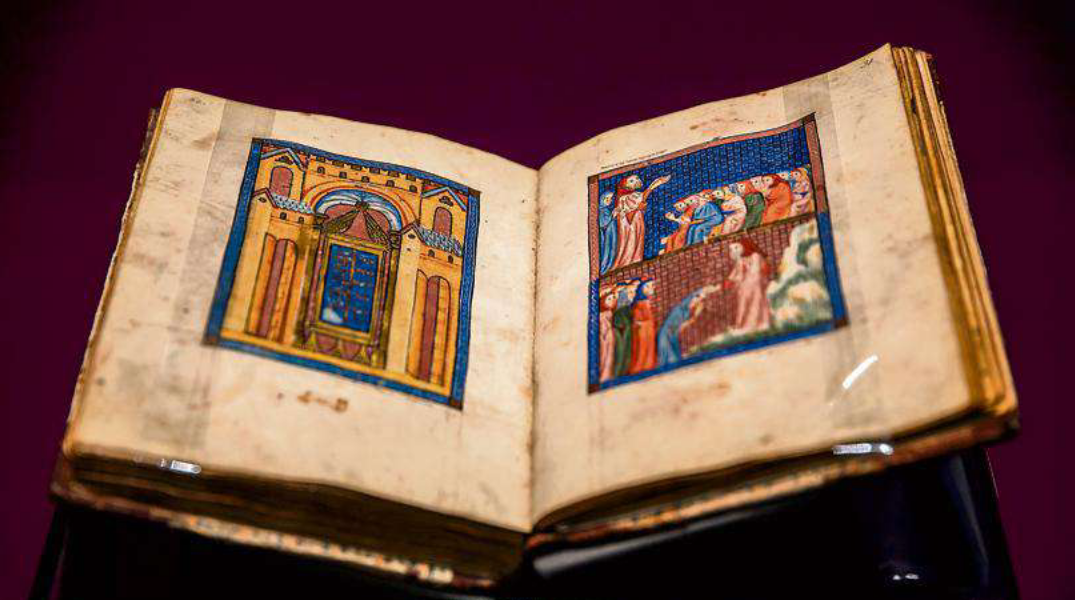
The Haggadah of Sarajevo is today preserved in the National Museum of Sarajevo. The richness and preservation of its illustrations make it the most precious Sephardic Haggadah in the world
Photo: Damir Sagolj for Le Monde
Enver Imamovic is an archaeologist and historian who teaches at the philosophy university next door to the museum. After two months of war, he is the first person to have the idea and the courage to try, at all costs, to save the Sarajevo Haggadah.
One June morning, he runs into Hamo Karkelja, a museum curator. He shares his idea of rescuing the Haggadah and asks the curator to join him. Both know that, after its extraordinary adventure in the Second World War and in addition to at least one theft attempt during the Yugoslav era, it is now kept in a secret place only known to the museum director, who, ill and bedridden, has now disappeared. Enver Imamovic therefore needs an ally who knows every nook and cranny of the building, to find where the manuscript might have been hidden.
The two men first go to the Ministry of Culture and Sciences where another professor from the philosophy faculty, acting as deputy minister in that period’s chaos, signs a document giving an official character to the mission. They then go see a police captain, asking him to assign them a combat unit to assist getting to the museum, and if necessary break open any safe. “The police officer asked me: “What is this damn book? Is it really worth someone dying for it?!” I replied that in my opinion, yes”, says Enver Imamovic.
This is why, as dawn broke on June 6, 1992, the historian Imamovic, the curator Karkelja, the officer Hajrudin Alispahic and two other policemen set off for the Marindvor neighbourhood and the museum. The bombings are intense. They get to the museum around 8.30am and find two other curators as well as the guard, Meho Mulic. Having continued to live there with his two young children, he has devoted the first weeks of the war single-handedly transporting antiquities and works of art from different pavilions down to the basements, to shelter them from the bombs.
“What is this damn book? Is it really worth someone dying for it?!”
The historians start their investigation in the director’s office: a safe has already been opened and pillaged; a policeman promptly opens a second safe. In it, they find antique gold and silver jewelry, as well as a Haggadah. Enver Imamovic, who has never seen the real Sarajevo Haggadah, quickly realises, because of the paper’s texture, that it is a reproduction.
Their trek continues to the museum basements, one room at a time, in the dark, with water up to their ankles. “Then, in a little room, I saw an old Austrian safe”, remembers Enver Imamovic. The policeman cannot do anything when confronted with this ancient safe with an unknown mechanic device. His keys and modern tools are powerless in the face of its Austro-Hungarian robustness.
The improvised commando unit of police and intellectuals are forced to attack the safe with chisels and axes. After a couple of hours, around 4.30pm, the door finally yields. Inside sits another safe also closed by key. The policeman is able to force open this lock without too much difficulty. Using a lighter, Enver Imamovic takes out the Haggadah and studies it, leafing through its illuminated pages. He touches the paper. “I sniffed the book and said: “Guys, this is the real Haggadah!””.
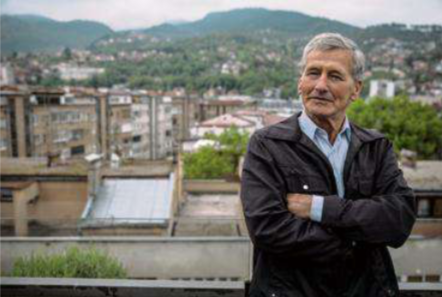
Archaeologist and historian Enver Imamovic teaches at the Faculty of Philosophy, next to the museum. In the spring of 1992, when the Serbian army bombed Sarajevo, he was the first to have the idea and the courage to try, at all costs, to save the Haggadah. Here in Sarajevo on May 15.
Photo: Damir Sagolj for Le Monde
Its rightful place in the museum
After a night under guard in the police headquarters, the Sarajevo Haggadah is placed by Enver Imamovic and his fellow accomplices in a safe of the central bank — the most secure place of the besieged city — where the new independent Republic of Bosnia & Herzegovina keeps its treasures, its money, and where, apparently, on certain nights of particularly violent bombardment, the president Alija Izetbegovic (1925-2003) sleeps for a few hours, sheltered from the war.
The problem is that, at the time, no one knew this story. A policeman indeed went the next day to notify the city’s Jewish community leaders Ivan Ceresnjes and Jakob Finci that the Haggadah was rescued but the Jewish representatives did not see it or talk to anyone about it. Hence, during the siege, as in the Second World War, the Haggadah is once again deemed to have disappeared, at least to the common man.
Because disappearances prompt fantasies and mysteries sometimes lead to lies, the unknown fate of the Holy book even caused a journalist to rashly write that the Muslim Bosnian authorities had sold it to buy arms. Rumours spread so quickly that, in the last year of the conflict, Ceresnjes and Finci suggested to President Izetbegovic to authorize a public display of the Haggadah for Passover.
“Izetbegovic asked me: “Where is it, this Haggadah?” I replied to him: “We have been told in a safe at the national bank”, Jacob Finci recalls. As Izetbegovic didn’t know who could get access to it, he called the Culture Minister, Enes Karic, who didn’t know either. Then he called the Prime Minister, Haris Silajdzic, and told him he had to sort out finding the Haggadah. Silajdzic oversaw the operation. We presented the Haggadah in the synagogue for Passover in April 1995, in the presence of Izetbegovic.”
The precious manuscript arrives at the synagogue in an armoured military vehicle. Rarely had so many military security forces been deployed during the siege in one place, even for the visit of a foreign head of state: the Bosnian special forces’ soldiers and policemen, the president’s security officers, UN “blue helmets” and US embassy guards.
In April 1995, the Sarajevian Jews take back ownership of a missing treasure, saved by a Muslim historian from bombing, and brought to the Synagogue by a Muslim president.
On that day, many of the officials present, including Jewish dignitaries, see the Haggadah for the first time in their lives. Before the Hazzan of Sarajevo, David Kamhi, celebrates the religious service and leads the prayer, many cannot help but leaf through the pages of the book, so long hidden from sight. The emotion of Jewish Sarajevans is palpable. Once again, they are taking possession of a lost treasure, rescued from the bombing of the museum by a Muslim historian and brought to the synagogue by a Muslim President. It is one of the siege’s powerful moments, a brief respite of peace during the war, and a symbol and testament to the fact that the city’s inter-community relations have been perhaps stronger than its attackers’ fascism.
Two rescues in a century
Today, the Haggadah has finally found a proper home, in room 37 of the national museum. It is on show on some of the visiting days. Touching and leafing through its pages as occurred in the spring of 1995 is out of the question. Sophisticated security protects the manuscript. Mirsad Sijaric, the director, opens the room and shows how the manuscript, kept under glass, can disappear, thanks to a special mechanism, and be replaced by a reproduction in two minutes.
The story of this Hebrew manuscript is then the story of the exceptional bond between a book and a city. Mirsad Sijaric still smiles remembering the amazement of the most recent expert who came to examine it, Israeli art historian, Shalom Sabar, from the Hebrew University of Jerusalem and author of “The Sarajevo Haggadah: History and Art (The National Museum of Bosnia Herzegovina, Sarajevo, 2018).
After a few days in the city, the historian confided to the museum director: “Which Londoner, Parisian or Viennese knows the value of the manuscripts buried within the depths of their city’s museums? In Sarajevo, I have not yet met a taxi driver who doesn’t talk to me passionately about the Haggadah!”
Many in Sarajevo are certain they know where Dervis Korkut hid the Haggadah during the Second World War, or how Enver Imamovic saved it during the Bosnian War. The most incredible tales circulate about the illuminated Jewish Sephardic manuscript’s two rescues in one century, illuminated again because of a Muslim librarian and then a Muslim historian. Even when the truth is sublime, this is how legends are made.
***
Parts 1 and 2 are translated by Sarah Robertson for the European Press Prize
SARAJEVO-JERUSALEM 3 | 6
The Jewish musketeers of the siege of Sarajevo
Throughout the Bosnian war, Sarajevo Jews find themselves at a new crossroad of history and their community launched an incredible humanitarian operation, organizing the evacuation of 2500 Sarajevans and providing assistance to the besieged. Israel, on the other hand, witnessed the arrival of hundreds of Sarajevan so little Jewish.
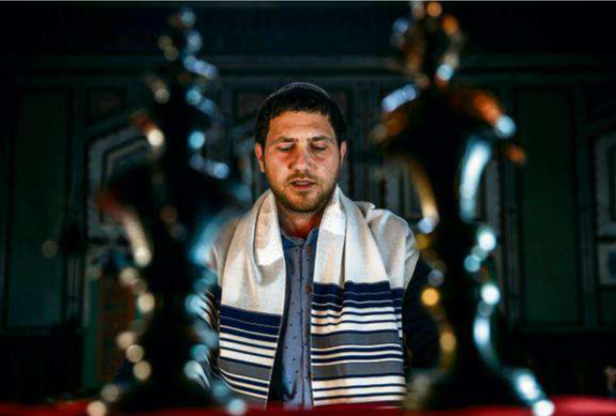
Igor Kozemjakin, whose father, Boris, was one of the organisers of the evacuation in the Bosnian war. Hazzan of his community, every Friday, Igor officiates for the Sabbath, in the only synagogue still in operation in Sarajevo.
Photo: Damir Sagolj for Le Monde
SARAJEVO-JERUSALEM 4 | 6
The peculiar customs of Sarajevo’s rabbis
Similar to the last Yugoslav rabbi Cadik Danon, a line of religious leaders, today personified by Eliezer Papo and Igor Kozemjakin, takes liberty with Jewish laws and traditions and represents, according to the current rabbi, “the true values of Judaism”. A vision of Judaism adjacent to Sarajevo’s spirit.
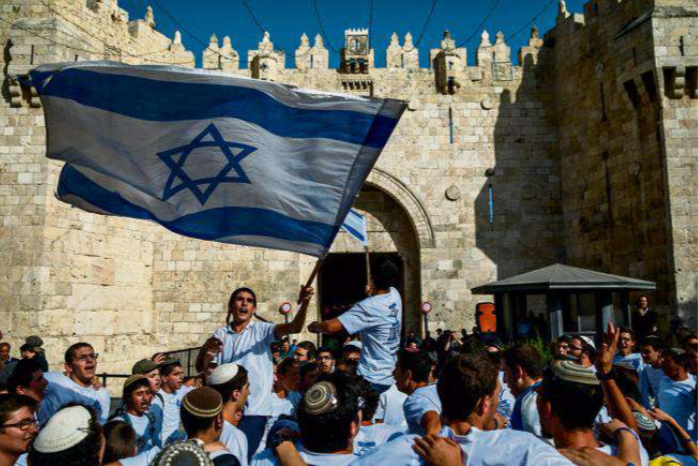
Young Israelis – outside the Damascus gate – celebrate the ‘Jerusalem Day’, which marks the takeover of the Holy City by the Israeli army during the 1967 war.
Photo: Damir Sagolj for Le Monde
SARAJEVO-JERUSALEM 5 | 6
From “Sarajevan education” to the Palestinian cause
A daughter of a Bergen-Belsen survivor from Sarajevo, Amira Hass has been the only Israeli citizen living in the Palestinian Occupied Territories for the last 25 years. Very critical towards Israeli colonizers, the journalist and columnist of the daily newspaper Haaretz continuously defends the Palestinian cause.
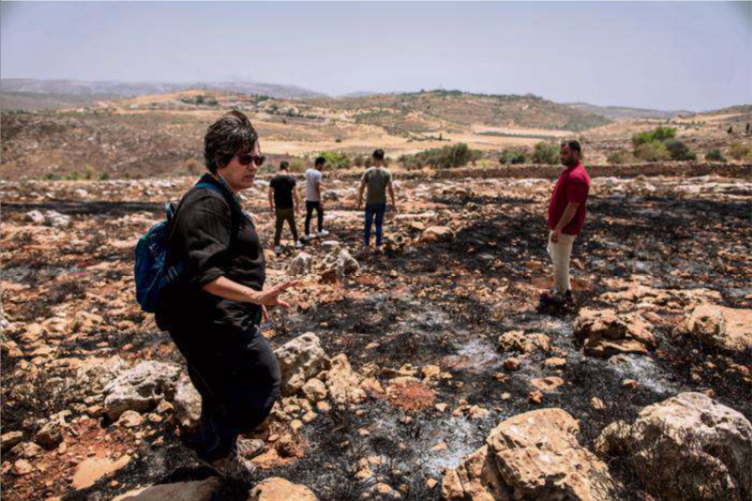
Amira Hass, Israeli journalist famous for her reports and editorials published in the daily newspaper “Haaretz”, chose to live in Ramallah, in the West Bank. Here, on June 7, she discovers the fields of olive trees of the Ibrahim family burned down by Israeli settlers the day before.
Photo: Damir Sagolj for Le Monde
SARAJEVO-JERUSALEM 6 | 6
Sarajevo-Jerusalem, two cities, two destinies
As opposed to Sarajevo which resisted the ethnic division of the city with the strength of despair, the inhabitants of Jerusalem live separately today, and the holy city is more fractured than ever.
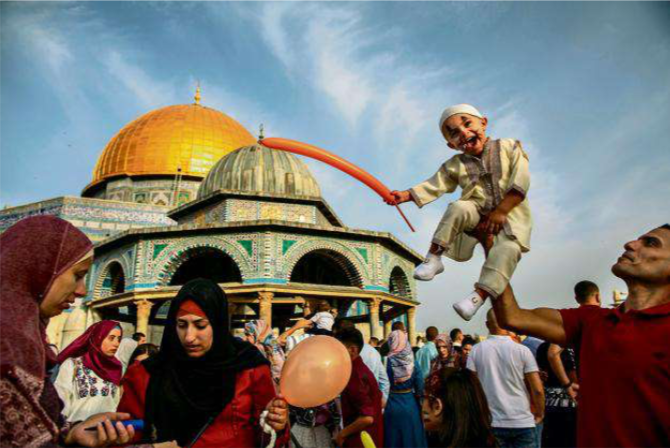
Palestinians celebrate the end of Ramadan at the Dome of the Rock in the Old City of Jerusalem on June 5.
Photo: Damir Sagolj for Le Monde


